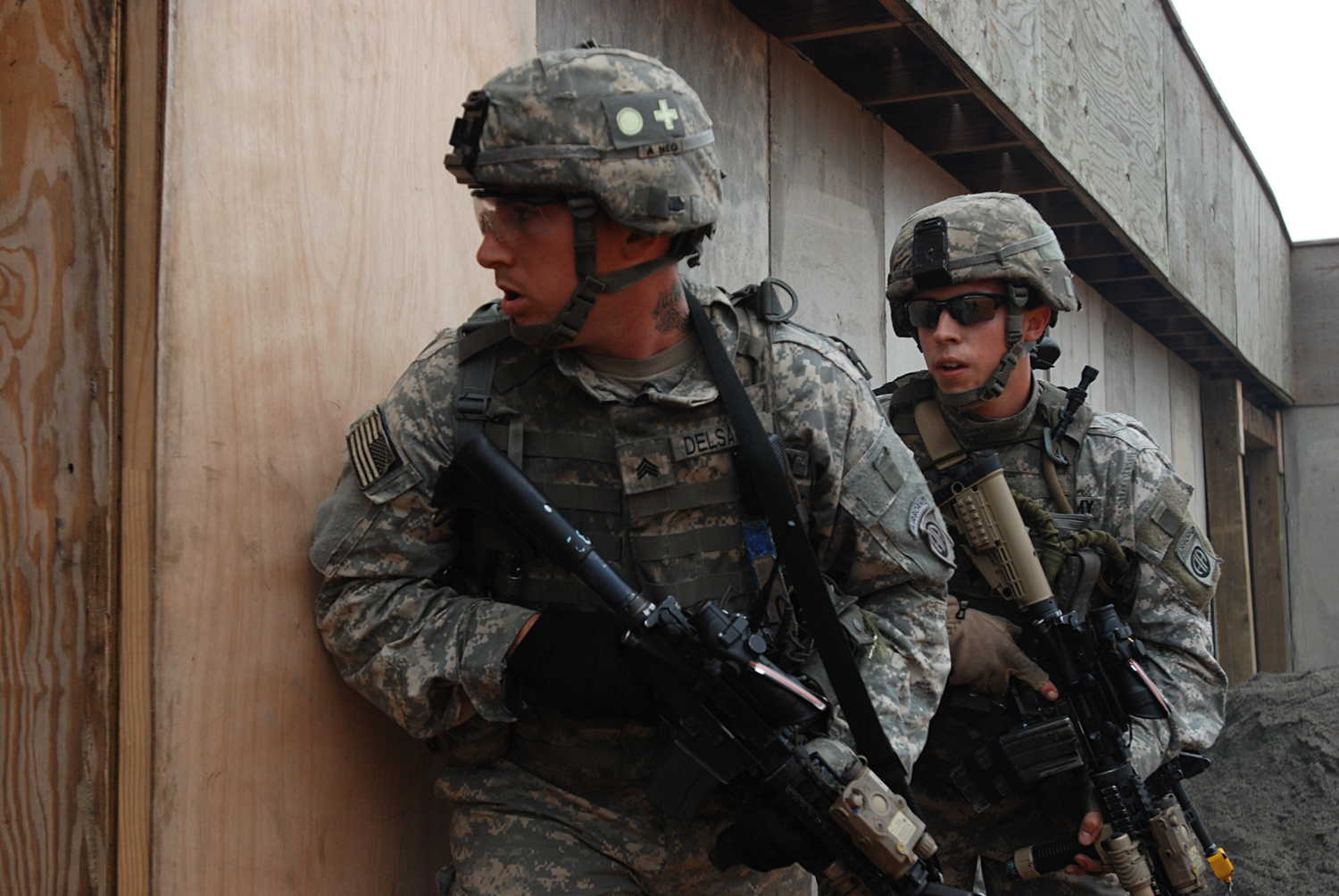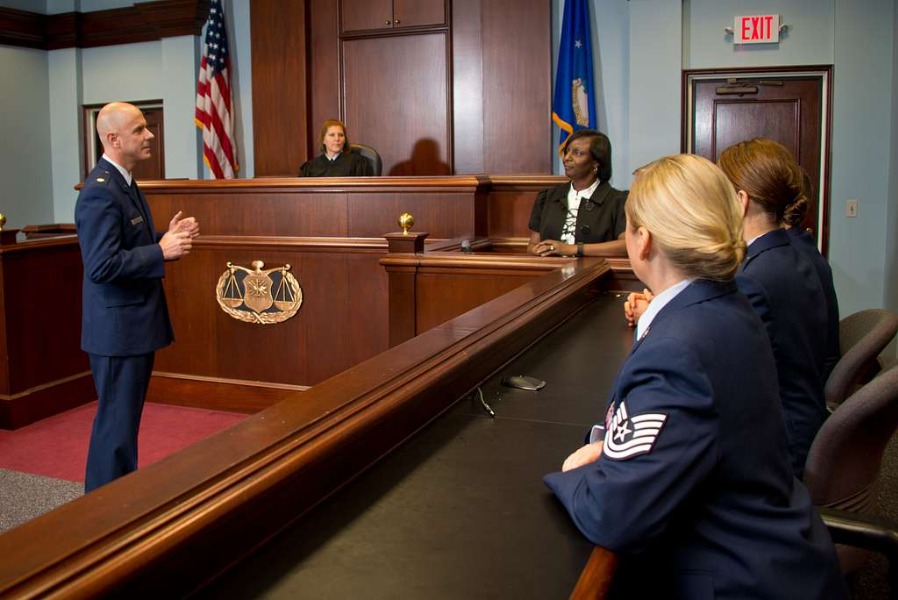Can Civilians Sue Military Personnel for Constitutional Violations?

Published by The Lawfare Institute
in Cooperation With

On April 5, the U.S. Army conducted a training exercise that would “simulate a situation [U.S. military] personnel might encounter in a deployed environment.” With the support of the FBI, service members executed the exercise, which consisted of a raid and detention of a “role player” in an “unfamiliar” environment: the Revere Hotel in Boston. Based on inaccurate information, however, the team entered the wrong hotel room and detained an unaware Delta Airlines employee, instead of the intended target: a trained actor waiting in a different room. The soldiers handcuffed and interrogated the man, placing him in the room’s shower for roughly 45 minutes before they realized their mistake. The U.S. Army Special Operations Command has since issued a public apology to the man.
Though the facts of this incident might raise observers’ eyebrows, military personnel—especially special operations forces—conduct training operations in civilian environments on a semi-frequent basis to provide service members with the experience of operating in an unfamiliar and realistic environment. For example, in October 2022, Army Special Forces executed the latest iteration of Robin Sage, the final exercise of their Special Forces Qualification pipeline, occurring over two weeks across 25 North Carolina counties. In a 2002 iteration of this exercise, a Moore County deputy—who claimed to be unaware of the exercise—shot and killed one service member who was wearing civilian clothing while participating in the exercise and injured another. In January 2021, the state of Washington approved the U.S. Navy’s use of 17 state parks for after-dark stealth training of SEAL teams in civilian clothing. In September 2022, Army personnel engaged in air and ground exercises, including close-quarter combat drills, in Phoenix and Peoria.
When these real-life simulations go awry, what causes of action, if any, are available to civilians, like the Delta Airlines employee, whose constitutional rights may have been violated by members of the armed forces during such exercises?
Claims Against Law Enforcement Officers
Violations of civil rights by federal government employees are governed by the framework set forth in the Supreme Court’s landmark 1971 decision Bivens v. Six Unknown Federal Narcotics Agents. In that case, the Court held that individuals may sue federal government officials for money damages when they violate their constitutional right against unreasonable searches and seizures. If the plaintiff can show that the defendant’s conduct “violate[d] clearly established statutory or constitutional rights of which a reasonable person would have known,” a plaintiff may be awarded damages (which is often the only available remedy after a constitutional violation).
In the 2007 case Wilkie v. Robbins, the Supreme Court provided a two-step test to determine whether a court should recognize a Bivens claim. First, a court should consider “whether any alternative, existing process for protecting the interests amounts to a convincing reason for the Judicial Branch to refrain from providing a new and freestanding remedy in damages.” In other words, a court should not recognize a claim where Congress has already created a statute to address the remedy, such as 42 U.S.C. § 1983, which allows civilians to sue state and local government employees for damages relating to constitutional rights violations. Second, assuming no such alternative exists, the court must then consider whether any “special factors ... counsel[] hesitation.” After a court finds that no special factors exist, or after it balances such factors against the interests of justice and individual liberty, it may determine whether to recognize the Bivens claim.
A critical backdrop to this analysis is the reality that recognizing a cause of action under Bivens is “a disfavored judicial activity,” as the Supreme Court articulated in 2016 in Ziglar v. Abbasi. The Supreme Court has recognized a Bivens cause of action in only three instances: against narcotics agents accused of arresting a man and searching his home without a warrant in Bivens itself; against a member of Congress for alleged sex-based discrimination; and against federal prison officials for failing to treat an inmate’s asthma, resulting in his death. In 12 other instances, it has declined to do so.
Applying Bivens to U.S. Military Personnel
In claims brought by military personnel against their superior officers and claims purely relating to matters of military action and policy, Bivens actions are precluded.
On two occasions, the Supreme Court has ruled against nonstatutory rights of action for damages against military personnel: first, in 1983 in Chappell v. Wallace, and then, in 1987 in United States v. Stanley. In those cases, and as summarized by the Seventh Circuit, the Court held that it is “inappropriate for the judiciary to create a right of action that would permit a soldier to collect damages from a superior officer.” Chappell and Stanley relied on the 1950 case Feres v. United States, which bars military personnel (but not civilians) from suing for injuries “incident to service.” The Court’s message to lower courts could be interpreted as the following: When Congress does not create a framework for plaintiffs to obtain damages against service members who do wrong, civilian courts ought not to interfere.
However, another interpretation of the case law implies that the Court has prohibited only service members from litigating in civilian courts in what essentially amounts to employment disputes against superiors. After all, service members have avenues within the military to seek redress for wrongs committed against them by superiors. In the U.S. Navy and Marine Corps, for example, these are Article 138 and 1150 complaints—referencing 10 U.S.C. § 938 and Article 1150, U.S. Naval Regulations—and the military justice system. Under this view, the Supreme Court has not explicitly foreclosed Bivens as a remedy for civilians to wield against service members.
Nevertheless, some lower courts—often when considering claims brought by military prisoners held during the global war on terror—have effectively barred civilians from obtaining damages against military personnel under Bivens for offenses as severe as torture. The most notable example is Vance v. Rumsfeld, a Seventh Circuit case from 2012 in which the court refused to recognize a “right of action for damages against soldiers (and others in the chain of command) who abusively interrogate or mistreat military prisoners.” In doing so, the Seventh Circuit created what amounts to absolute immunity from Bivens liability for all members of the U.S. military from claims raised by civilians. As support for its holding, the panel pointed to then-recently issued opinions by the Fourth Circuit (Lebron v. Rumsfeld) and D.C. Circuit (Meshal v. Higgenbotham; Doe v. Rumsfeld; Ali v. Rumsfeld) in which those courts also declined to extend Bivens to claims by military prisoners against members of the armed forces.
The Vance court reasoned that “plaintiffs do not need a common-law remedy in order to achieve some recompense for wrongs done them,” as that recompense could be obtained by filing suits under the mutually exclusive Federal Tort Claims Act (FTCA), Military Claims Act (MCA), Foreign Claims Act (FCA), 28 U.S.C. Chapter 171, 10 U.S.C. § 2733, and 10 U.S.C. § 2734. These statutes shield federal officers and employees from personal liability committed within the scope of their employment but allow civilians to obtain some compensation for the wrongs done to them by government personnel.
The FTCA specifically authorizes plaintiffs to bring a civil lawsuit in federal civilian court against the United States for damages based on an injury caused by a federal employee’s negligent or wrongful act or omission that would be cognizable under state tort law. The FTCA, however, does not extend to civil actions based on constitutional violations or many intentional torts. For example, in the 1994 case Hallett v. U.S. Department of the Navy, a group of civilian women were unable to sue the United States under the FTCA for “sexual assaults and batteries allegedly perpetrated by Naval officers” at the 1991 Tailhook Convention because those alleged assaults were “specifically exempted from the FTCA's jurisdictional grant.”
Similarly, the MCA and FCA do not apply to claims for constitutional violations or intentional torts—including assault, battery, and false imprisonment—rendering them of little use to civilians in situations similar to that of the Delta employee in Boston. Unlike the FTCA, however, damages are statutorily capped under the MCA and FCA, the decision of whether to award relief under either is left to the discretion of the defense secretary, and these statutes do not provide a mechanism for judicial review of the secretary’s decisions.
In all, these statutes are imperfect substitutes for a Bivens remedy. Nevertheless, because these statutes exist, the Seventh Circuit was satisfied that the plaintiffs could not claim relief under Bivens.
Cases brought by civilians who are not military prisoners are also unlikely to avail a Bivens remedy for many of the reasons discussed in Vance. For example, in the 2019 Fourth Circuit case of Doe v. Meron, the court declined to recognize a civilian’s claims against naval officers because multiple special factors counseled against extending a Bivens remedy, including that it arose in the military context, would require extraterritorial application of Bivens, and the plaintiff could rely on the MCA. And in Ellawendy v. Takagaki, the district court was satisfied in dismissing a claim based on a purported unlawful seizure simply because it occurred in a military context. The court did not find it necessary to determine if the defendant-police officer was a civilian employee or a service member.
Thus, as the case law currently stands, civilians most likely will be unsuccessful in seeking judicial remedies against military personnel for constitutional violations or intentional torts. Though not every appeals court has ruled on this issue, Vance and the other appellate decisions that it cites together form an imposing obstacle that other circuits and lower courts will likely be hesitant to contradict.
Civilian Suits Against National Guard Members
The same is true for suits by civilians against members of the National Guard. As a general matter, the National Guard occupies a unique, hybrid position in the armed services. Its members typically hold full-time civilian jobs and part-time Guard positions and assume their Guard duties upon activation. Crucially, Guard members are state employees and operate under the control of their respective state’s governor after being activated in the event of a state emergency. They also, however, fall under the president’s chain of command upon the declaration of a national emergency.
Given this dual role, some plaintiffs (many of whom were National Guard members themselves) have tried to press claims against National Guard members under § 1983, without success. The leading case here is Knutson v. Wisconsin Air National Guard, a 1993 case in which the Seventh Circuit held that National Guard members are protected from § 1983 claims brought by subordinates. As an initial matter, the court found that the plaintiff’s claim fell under § 1983, as the defendants were acting under the color of state law. Ultimately, however, the court found the claim not justiciable regardless of whether the member was acting under a state or federal chain of command. Acknowledging the parallels between § 1983 and the cause of action created under Bivens, the panel found that the logic of Chappell—in which the Supreme Court relied on the “special factors” specific to the military to hold that military members cannot bring Bivens claims against their superiors—applies to § 1983 claims. It also noted that several other circuits had reached the same conclusion, though it quibbled with their underlying rationale.
In sum, though no court has expressly barred all civilians from bringing any type of § 1983 or Bivens suits against National Guard members, the case law again demonstrates a deep reluctance by the judiciary to extend those remedies in the context of the military.
Equitable Claims
Although it is clear that claims for damages raised by National Guard members and service members are barred, the circuit courts are currently split on whether they can seek equitable relief for alleged constitutional violations. On the one hand, the Second, Fifth, Seventh, Eighth, Ninth, Eleventh, and D.C. Circuits have concluded no: The only justiciable intramilitary claims are facial challenges to the constitutionality of military regulations. On the other hand, the First, Third, and Tenth Circuits have entertained individualized equitable actions. The Fourth and Sixth Circuits have not explicitly considered the issue under the Chappell-Stanley-Feres framework.
As for civilians making equitable claims, the courts are likely to be split in the same way. With regard to constitutional violations that do not concern personnel actions or intentional torts, such harms are unlikely to be continuing and worthy of equitable relief. As a result, there are few, if any, cases where civilians have requested equitable relief based on military action (except in the military prisoner context). That said, where the civilian’s claim arises solely in the context of his her status as a civilian (meaning civilian employment by the military) and the defendant’s actions are not incident to his or her service, there might be an avenue for equitable relief.
However, where the equitable claim may disturb the independent decision-making of military officials, the chain of command, or the operation and effectiveness of the military, such claims are unlikely to be entertained by the civilian courts. Furthermore, given the Supreme Court’s consistent broadening of the intramilitary immunity doctrine and the rule of deference it announced in Chappell, the Court is likely to preclude equitable claims based on individualized military decision-making regardless of the plaintiff’s status. At that point, only facial challenges to the constitutionality of military regulations will likely be able to be heard in civilian courts.
A Recent Shift in the Law
Notably, Vance and the other circuit cases that it cites stand as an inflection point on this question. Prior to their issuance, no court had indicated that civilians were categorically prohibited from bringing Bivens claims against military personnel. For example, in Saucier v. Katz, the Supreme Court held that a military police officer was entitled to qualified immunity on a civilian’s Bivens claim for excessive force only after rigorous analysis on the merits. The Court did not hint that the civilian categorically could not sue the military police officer for the alleged constitutional violation. If the majority in Vance were correct, though, the Court would have simply rejected the Bivens claim in Saucier at the outset without exploring the nuances of qualified immunity doctrine before reaching its conclusion. The Court has since overruled Saucier on other grounds, but this particular holding still stands.
Prior to Vance, circuit and district courts decided many Bivens cases brought by civilians against military personnel. Such claims almost always failed on other grounds, but those courts did not bar civilians from seeking relief under Bivens for the alleged wrongdoing as a rule. For example, in Applewhite v. United States Air Force, the Tenth Circuit considered a civilian’s Bivens claim against a military police officer and the secretary of the Army for an alleged unlawful search and removal on a military base. Similarly, in Morgan v. United States, the Ninth Circuit assessed the district court’s dismissal of a civilian’s Bivens claim against military police for an allegedly improper vehicle search. Even the Seventh Circuit considered an allegation of wrongful search and seizure by military police officers in Case v. Milewski before affirming the lower court’s dismissal of the case for failure to state a claim.
Again, this jurisprudence among the lower courts has taken place against the backdrop of the Supreme Court’s consistent hostility toward expanding Bivens and its progeny. It is perhaps not surprising that lower courts view these claims with increased skepticism and point to the contextual special factors, rather than analyzing the merits of the claims, in actions against members of the military.
Thus, it appears that courts’ categorical hostility to civilians’ Bivens claims against military personnel is a relatively recent development—perhaps a combination of the judiciary’s deference to the military and a recognition of the Supreme Court’s increasing refusal to expand Bivens. In fact, even if the Delta Airlines employee were able to pursue a Bivens claim, it is unlikely that he would be victorious, given the narrow circumstances in which such a remedy is cognizable.
Furthermore, while the courts are unanimous in finding that service members’ claims for damages are not justiciable, there is still a split with regard to equitable relief—though only three circuits currently entertain such claims. Most of these cases were published between the 1980s and early 2000s; and it is unclear, if revisited, whether the minority view will still stand. If the majority view becomes the unanimous view, as is likely based on the current Supreme Court posture, equitable claims based on individualized military decision-making will also be beyond the reach of civilian plaintiffs.
Conclusion
Whatever the motivation behind it, this trend is likely to continue for the foreseeable future. At this point, the best assessment of this complex legal landscape is that damages claims by civilians against both service members and members of the National Guard are functionally impossible to obtain, even if they are not formally prohibited. There is somewhat more ambiguity when it comes to individualized equitable claims, with success contingent on the circuit in which the claim is raised. The bottom line, however, is that courts are increasingly comfortable denying a plaintiff’s Bivens claim or equitable claim due to the factual connection to the military.
Therefore, the exact status of the plaintiff seems less important in this context. No federal court will be eager to push back against both the Supreme Court and several circuits by choosing to broaden Bivens’s scope to include civilian suits against military personnel or in the military context, even if failing to do so leaves a sizable gap in the framework of remedies available to plaintiffs. Unless Congress creates a statutory remedy or the federal judiciary drastically changes its tune, plaintiffs like the Delta Airlines employee will face an uphill battle in court against military personnel who allegedly violated their constitutional rights or committed intentional torts.
Disclaimer: Although one of the authors is an officer in the United States Navy, the opinions and assertions expressed in this article are those of the authors and do not necessarily reflect the official policy or position of the United States Government, the Department of Defense, or the Department of the Navy. The analysis presented here stems from her academic research of publicly available sources.






